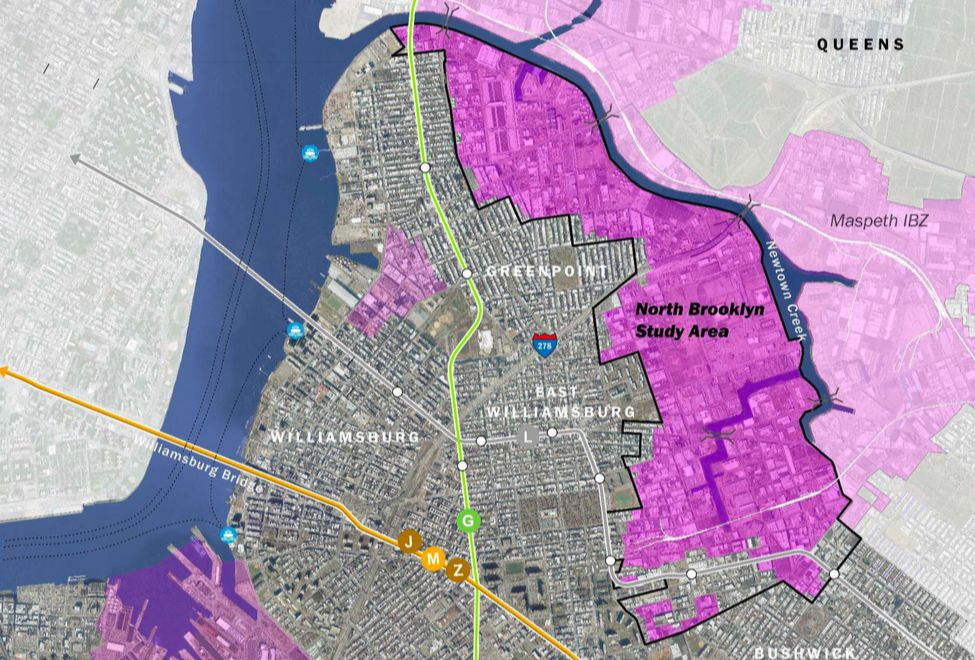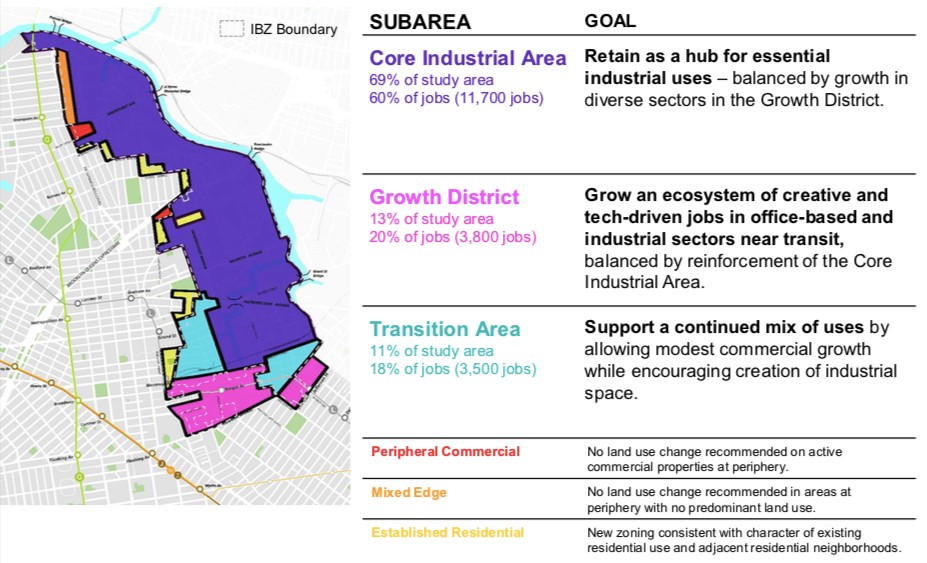A New Plan For The North Brooklyn Industrial Zone, But With Concrete Answers To Come


This week, representatives from the NYC Department of City Planning (DCP) visited North Brooklyn’s Community Board 1 to talk over their bold vision for creating jobs through zoning changes to the North Brooklyn Industrial Business Zone (IBZ).
Once in front of the community, however, questions from the board revealed the DCP has few concrete answers about the changes they are suggesting—though there will be time for local input in the new year.
Released just days before Thanksgiving, 168-page report is the result of years of study of New York’s third-largest Industrial Business Zone, which spans the east side of Greenpoint from Newtown Creek down into East Williamsburg and terminates at Flushing Avenue, on the Bushwick border.
The main goal: to “modernize outdated industrial zoning,” according to a statement by DPC Director Marisa Lago.
“This will allow businesses—from construction and distribution, to custom manufacturing and food production, to creative tech and media—to build more jobs in this IBZ, for the benefit of all New Yorkers and especially for local residents,” Lago said in the report’s press release.
According to the DCP, there are three main goals in modernizing North Brooklyn’s Industrial Business Zone.

The first is to loosen up zoning regulations the Core Industrial Area, which comprises two-thirds of the total area. Currently, the Floor to Area Ratio doesn’t exceed 2.0 and the zoning hasn’t been updated since the zoning regulations of 1961.
Increasing the FAR would allow industrial and manufacturing businesses to expand their space, and the study looks to “adjust industrial floor area to allow for multiple floors of industrial space,” ideally attracting more jobs. That would mean growth upward in an area traditionally dominated by one and two-story buildings.
At the same time, the study suggests limiting “large-scale entertainment,” which would theoretically keep high-traffic destinations like music venues from expanding too deep into areas designed for heavy trucks.
Of course, not all the study area is deep industrial neighborhoods—it does eventually run up against commercial businesses, restaurants and residential neighborhoods. Naturally, the DCP has plans for those areas as well.
In the middle Growth District, the goal is to increase job density, which means focusing on “growing an ecosystem of creative and tech-driven jobs.”
That means encouraging the growth of loft-style buildings, and if creative/tech hubs like DUMBO are any indication, that’s exactly the kind of development that will attract, new, dynamic businesses in search of open layouts and high ceilings.
Additionally, the plan for the Growth Districts will lower the restrictive industrial parking requirements that act as a brake on development in these areas. The idea is to attract commuters that either use public transit or, ideally, create jobs available to neighborhood residents that could walk to work.
Finally, there’s the Transition Area, where similar goals are in place. However, the language is modified, as the plan is to “modestly” increase permitted density in the area, while still encouraging the construction of loft-style buildings and reducing parking requirements.
The focus of the plan is clearly on jobs growth. After losing jobs in the first decade of the 21st century, the North Brooklyn IBZ gained more than 2,000 jobs between 2010 and 2016—a trend that the city would like to see continue as Brooklyn packs on population.
“For decades, industrial jobs have served as critical pathways to the middle class among historically disenfranchised communities in my district and across the City,” said Council Member Antonio Reynoso about the plan.
“The recommendations outlined in this report to protect core industrial areas in the North Brooklyn IBZ will go a long way towards ensuring this area continues to serve as an economic generator for generations to come,” he added.
However, when presented to Community Board 1 this week, it was clear that while the general goal of job growth is clear, the DCP isn’t ready to commit to any specifics. A represetative said the goal is to grow to at least a 2.0 FAR in key industrial areas, and tossed around a range of 3.0-5.0 in Transition areas.
When asked what constitutes “large-scale entertainment,” a promise to further investigate was the answer.
Others were concerned about the potential for displacement of business owners or residents who have carved out spaces in transitional areas. With reductions in parking and already narrow streets in the area, others were worried about the potential for increased traffic due to growth. To both, DCP reps demurred, promising to engage with the community in the future.
That means more meetings, with a public meeting on the zoning framework proposed for Winter 2019. Following that session of input, the DCP would like to make adjustments to their proposal in the Spring and have the zoning certified by the end of the year.




